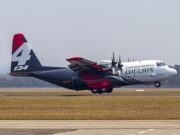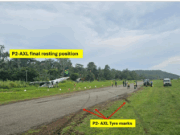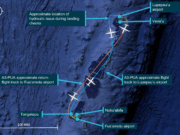
The following information provides an awareness of problems that might be avoided in the future. The information is based on final reports by official investigative authorities on aircraft accidents and incidents.
 Jets
Jets
Controller Was ‘Preoccupied’
Boeing 767-300. No damage. No injuries.
Five controllers were on duty in the control tower at Tokushima (Japan) Aerodrome the morning of April 5, 2015. However, the supervising controller had sent four of the controllers elsewhere to attend to maintenance tasks associated with preparations for an upcoming inspection of the facility. Although the minimum tower complement is two, the supervisor believed the traffic volume that morning was low enough for one person to handle it.
At about 1040 local time, an airport maintenance technician radioed the tower to request clearance to drive a work vehicle onto Runway 11/29 so that he could replace the bulbs in some runway distance-marker lights. The controller approved the request, intending to instruct the technician to vacate the runway before the arrival of a 767 that was inbound to land on Runway 29, said the report by the Japan Transport Safety Board (JTSB).
Contrary to common practice, however, the controller did not hang a sign on the airport wind indicator as a reminder that the runway temporarily was not available due to maintenance. The report said that, after clearing the maintenance technician to drive the work vehicle onto the runway, he became preoccupied with the flight crew of an aircraft on the ramp who were requesting clearance to depart on Runway 11.
The crew of the inbound 767 established radio communications with the controller at 1053. Having forgotten about the work vehicle and lacking the usual visual reminder that the runway was occupied, the controller cleared the crew to land on Runway 29.
At the time, surface winds were from 180 degrees at 20 kt. Visibility was greater than 10 km (6 mi), and the sky was overcast at 1,000 ft. Due to the ceiling and lower visibilities in rain showers near the airport, the 767 crew had requested and received clearance from approach control to conduct the instrument landing system (ILS) approach to Runway 29. During their approach briefing, the pilots had discussed landing with the left quartering tail wind.
The first officer, the pilot monitoring, saw the runway after the 767 broke out of the overcast about 3 nm (6 km) from the airport. As the aircraft passed over the runway threshold, the first officer saw the work vehicle and called for a go-around. The captain, who had begun to flare the aircraft for landing, responded almost immediately. The 767, which had 59 passengers and seven crewmembers aboard, passed about 40 ft over the vehicle during the go-around. The crew subsequently landed the aircraft without further incident.
Going Around and Around
Boeing 737-800. No damage. No injuries.
The 737 was en route with 142 passengers and eight crewmembers from Doha, Qatar, to Cochin, India, the night of Aug. 18, 2015. The forecast called for 4,000 m (2 1/2 mi) visibility and scattered clouds at 1,500 ft at Cochin. However, as the aircraft neared the airport, which is on the southeast coast of India, the flight crew was advised that visibility was 3,500 m (about 2 1/4 mi) in haze. The weather conditions deteriorated further as the flight progressed.
The crew was cleared to conduct the ILS approach to Cochin’s Runway 27. Published minimums for the approach included a runway visual range (RVR) of 650 m (2,100 ft) and a decision height of 320 ft. “During approach, the flight crew was not able to make visual contact with the runway due to low clouds and initiated a go-around,” said the report by India’s Directorate General of Civil Aviation (DGAC).
While maneuvering the aircraft for another ILS approach to Runway 27, the pilots discussed the weather conditions at their filed alternate, Bangalore, which was 375 km (203 nm) northeast, as well as at Trivandrum, 200 km (108 nm) south. The aircraft’s fuel supply was nearing the minimum required to divert to Bangalore, and the crew decided to change their alternate to the closer airport. The ILS approach at Trivandrum was out of service, but the reported visibility of 3,000 m (about 2 mi) was adequate for the airport’s VOR/DME (VHF omnidirectional radio/distance-measuring equipment) approach.
The crew conducted two more ILS approaches to Cochin but did not obtain the required visual references for landing upon reaching decision height. “After the third go-around, the crew set course and diverted to Trivandrum,” the report said.
The weather conditions at Trivandrum also were deteriorating. Nearing the airport, the crew was advised that visibility had decreased to 1,500 m (5,000 ft) in haze. “The visibility requirement was RVR 2100 m [6,800 ft] for [the VOR/DME approach to] Runway 14,” the report said. “The crew had informed ATC [air traffic control] about minimum fuel conditions.”
For the fourth time, the crew had to conduct a missed approach. They declared an emergency, and the pilot-in-command (PIC) told ATC that he was going to conduct a visual approach to Runway 14. The first attempt resulted in a go-around. The aircraft was 700 ft above the ground on the second visual approach when the pilots saw the runway too late to land.
The PIC then told ATC that he was going to make a 180-degree turn and “self-position” to land on Runway 32, the report said. The aircraft’s enhanced ground-proximity warning system (EGPWS) generated several terrain and bank angle warnings during the approach. “The PIC continued the approach with all the warnings and with no visual contact with the runway, and finally landed on Runway 32,” the report said.
The 737 was very low on fuel: It had arrived at Cochin with 4,844 kg (10,679 lb) of fuel; 379 kg (836 lb) of fuel remained after the landing at Trivandrum.
The DGAC concluded that the probable cause of the serious incident was “the absence of a company policy pertaining to the number of approaches/missed approaches … and to the re-designation of [alternate airports] during flight in inclement weather.”
Descent Below Minimums
Airbus A320-200. Substantial damage. Twenty-eight minor injuries.
Inbound from Incheon, South Korea, with 74 passengers and eight crewmembers the night of April 14, 2015, the flight crew was cleared to conduct the global positioning system (GPS) approach to Runway 28 at Hiroshima, Japan. Minimum RVR for the nonprecision approach was 1,400 m (about 4,500 ft), and the decision altitude was 1,500 ft (433 ft above runway touchdown zone elevation).
The reported touchdown zone RVR was 1,700 m (about 5,500 ft) when the crew began the approach, but the RVR decreased to 550 m (about 1,800 ft) in fog and light rain as the A320 neared decision altitude. The pilots initially had the runway in sight but lost sight of it as the approach progressed. They were not advised by ATC of the rapidly decreasing RVR, the JTSB report said.
Shortly before reaching decision altitude, the first officer, the pilot monitoring, said “Wow, getting invisible in a second.” Although he did not have the required visual references in sight to continue the approach when he subsequently called out “minimum,” he did not call for a go-around. In response to the first officer’s callout, the PIC said “continue.”
“It is probable that the PIC could see visual references partially or intermittently below [decision altitude],” the report said. “However, he might have been caught in a situation where the position of the aircraft could not be identified by visual references. Therefore, he should have executed a go-around immediately.”
A few seconds after calling “minimum,” the first officer said, “runway not in sight.” The PIC responded, “Wait a second,” but a few seconds later, he said, “No runway, go around.” The first officer responded “yes.”
The PIC pulled his sidestick control all the way back and applied takeoff/go-around power. Vertical acceleration was 2.0 g and the aircraft’s descent rate had been reduced to almost zero when the A320 touched down short of the runway, struck localizer antennas, continued onto the runway and then came to a stop off the left side of the runway. Twenty-six passengers and two crewmembers sustained minor injuries.
The JSTB concluded that the accident was caused by the unwarranted descent below minimums and that the flight crew’s noncompliance with standard operating procedures and their inadequate crew resource management during the approach likely resulted from insufficient training by the company.
Engine Fire Traced to Weld Repair
Avro 146-RJ100. Substantial damage. No injuries.
The four-engine aircraft was on initial climb from Perth, Australia, for a charter flight with 87 passengers and six crewmembers the morning of April 29, 2014, when the flight crew received warnings of a fire in the no. 2 engine. They shut down the engine, activated the fire-suppression system and returned to the airport, where the Avro was landed without further incident, according to the report by the Australian Transport Safety Bureau (ATSB).
Examination of the Honeywell LF507 engine revealed that a welded boss in the combustion section housing had fractured due to fatigue, allowing hot gases to burn through the housing and the engine cowling.
Investigators found that during an unauthorized weld repair, grinding of the inner and outer surfaces of the housing near the boss had reduced the wall thickness and led to the formation of cracks. “The ATSB [also] found that the normal scheduled visual inspection of the housing, which was designed to find cracks before they developed into a fracture, was ineffective in this case,” the report said.
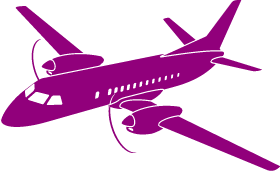 Turboprops
Turboprops
Control Lost During Training
Cessna 208B. Destroyed. Two fatalities.
A newly hired copilot was receiving his first training flight with a check airman in the vicinity of Bethel, Alaska, U.S., the afternoon of April 8, 2014. Recorded ATC radar data showed typical training maneuvers for about 20 minutes before the Caravan descended rapidly from 3,500 ft and struck terrain.
Interviews with company pilots and a review of archived radar data indicated that the upset occurred when the check airman simulated an in-flight emergency, said the report by the U.S. National Transportation Safety Board (NTSB). Investigators determined that the check airman likely applied nose-down elevator trim to simulate an electric pitch trim system runaway.
“Simulated airplane performance calculations showed that during a pitch trim excursion, the control forces required to counter the anomaly [in a 208B] increase to unmanageable levels unless the appropriate remedial procedures are quickly applied,” the report said.
The NTSB concluded that “the [trainee], who lacked experience in the airplane type, did not appropriately respond to the excursion. The check airman did not take remedial action and initiate the recovery procedure in time to prevent the control forces from becoming unmanageable.”
‘Smoke in the Cockpit’
Piper Cheyenne II. Destroyed. Four fatalities.
The flight from Orlando, Florida, U.S., had been uneventful, but shortly after establishing radio communication with the airport traffic controller during a visual approach to Fort Lauderdale Executive Airport the afternoon of April 12, 2015, the pilot declared an emergency and reported “smoke in the cockpit.” The controller cleared the pilot to land on any runway.
About a minute later, the Cheyenne pitched nose-down and descended into a wooded area about 0.75 mi (1.21 km) from the threshold of Runway 13. The pilot and his three passengers were killed, but no one on the ground was hurt. The airplane was destroyed by the impact and a fire that consumed the cockpit and center fuselage.
Examination of the engines and propellers revealed that they were producing significant power on impact, but investigators were unable to determine the cause of the fire due to the extent of the damage. The NTSB concluded that the probable cause of the accident was “a rapid onset of smoke and/or fire in flight.”
The report noted that the pilot had received initial training in the Cheyenne about a week before the accident and that the newly purchased airplane had recently undergone an annual inspection and extensive upgrades to its avionics equipment.
Copilot Loses Consciousness
Bombardier Q400. No damage. No injuries.
The flight crew had begun the descent to Dublin, Ireland, the afternoon of April 27, 2016, when the copilot requested permission to leave the cockpit to use the lavatory. The commander approved the request and used the intercom to ask the senior cabin crewmember to come forward and attend the cockpit while the copilot was absent. As the copilot was vacating his seat, the commander felt the aircraft unexpectedly yaw and roll 18 degrees left.
“The copilot, who had become incapacitated, had inadvertently made an input to the left rudder pedal,” said the report by the Air Accident Investigation Unit of Ireland. The commander recovered control of the aircraft and declared an urgency due to the copilot’s incapacitation. ATC provided priority handling for the Q400’s arrival and approach.
A cabin crewmember occupied the cockpit jump seat, and the senior cabin crewmember managed the cabin with the help of a briefed passenger while the commander landed the aircraft without further incident.
“When the aircraft arrived on stand, the copilot had recovered considerably; however, he was brought to a hospital in Dublin as a precaution,” the report said. “It was determined that the copilot [had] suffered a brief loss of consciousness (syncope) due to a sudden drop in blood pressure. This condition can commonly occur in healthy people, and recovery is normally prompt and without any persisting ill effects.”
Noting that the copilot’s “young child had a hospital appointment the following day,” the report said that “stress and lack of quality sleep may have been factors in his feeling unwell and incapacitation during the flight.”
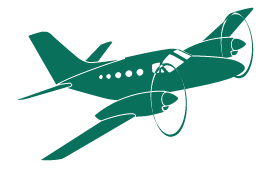 Piston Airplanes
Piston Airplanes
Excursion on a Dirt Strip
Cessna 404. Substantial damage. Two minor injuries.
Before departing from Broome Airport in Western Australia for a charter flight with five passengers to an unimproved airstrip in Pantijan the afternoon of April 12, 2015, the pilot was told by a contact person at the airstrip that the runway was flanked by tall grass and termite mounds. The pilot was told that due to rising terrain to the northeast, he should land on Runway 02 and depart from Runway 20.
“He was also advised that the threshold of Runway 02 had grass cover and that midway along the strip, the surface was soft,” the ATSB report said. “The pilot understood that the contact person had walked the strip to assess its condition but that no vehicle had been available to drive across the landing surface.”
Upon arrival, the pilot flew over the airstrip at 700 ft and noticed that he would have a 5-kt tailwind during the landing on Runway 02. “The pilot observed that the runway was narrow and bordered by tall grass,” the report said. “A termite mound was located about halfway along the runway and had been placed on its side and moved to the right of the runway centerline.”
During the landing, the 404 touched down near the runway threshold. “As it slowed through about 60 kt, the pilot applied left rudder … to increase separation from the overturned termite mound,” the report said. “He felt the rudder pedals move to the full left position, and the aircraft turned to the left.” The nose landing gear collapsed after striking a hidden runway marker, and the aircraft skidded to a stop. The 404 was substantially damaged, and two passengers sustained minor injuries.
Nose Gear Bolt Overlooked
Cessna 402C. Substantial damage. No injuries.
While departing from Fort Lauderdale (Florida, U.S.) Executive Airport for a positioning flight to the Turks and Caicos Islands the afternoon of April 1, 2013, the pilot observed an indication that the nose landing gear had not retracted. He said that he “completed the emergency check” and received indications that all three landing gear were down and locked.
The pilot returned to the airport. As the 402 decelerated during the landing roll, the nose landing gear collapsed. “The airplane’s nose and propellers contacted the runway, which resulted in substantial damage to the airplane,” the NTSB report said. The pilot was not hurt.
Investigators found that during maintenance performed before departure, a maintenance technician had removed a bolt from the nose landing gear drag brace in preparation for an inspection by another technician. Neither technician documented the action, however.
“Evidence indicates that the bolt was not reinstalled, which should have been detected during a post-maintenance inspection,” the report said. However, the facility’s chief inspector told investigators that due to the lack of documentation, “it did not occur to him to inspect [the drag brace] before releasing the airplane to service.”
 Helicopters
Helicopters
Long Line Forgotten
Bell 206L-4. Substantial damage. One minor injury.
The pilot was returning to a hilltop helipad in Hualapai, Arizona, U.S., that served as the base for his company’s external-load operations the afternoon of April 6, 2016. He told investigators he forgot that the long line, holding two empty cargo nets, was still attached to the helicopter.
The pilot conducted a normal approach, rather than a long-line approach, to the helipad. “Subsequently, the 100-ft [30-m] long line snagged on a ridgeline, and the helicopter jerked in an uncontrollable turn to the right, touched down right-skid-first and rolled over,” the NTSB report said. The pilot sustained minor injuries, and the LongRanger’s tail boom was substantially damaged.
After the accident, the company revised its “Before Takeoff” and “Descent and Landing” checklists to require a check of the cargo hook. The company also directed that, whenever possible, all takeoffs and landings be observed by a company employee on the ground who can use a radio or hand signals to alert the pilot about any unsafe condition.
Anti-Torque Pedals Locked
MD Helicopters 500. Substantial damage. One serious injury.
The pilot, who held an airframe and power plant mechanic certificate, secured the helicopter’s left anti-torque pedals to keep them out of the way while he installed a new battery the morning of April 8, 2016. However, he forgot to free the pedals before subsequently attempting a post-maintenance test flight at Weatherford, Texas, U.S.
When the pilot applied collective control to enter a hover, the helicopter lifted off the ground, spun several times, traveled about 40 ft (12 m) and struck trees and a building, the NTSB report said. The pilot was seriously injured, and the helicopter’s main rotor system, fuselage, tail boom and tail rotor system were substantially damaged.
| Date | Location | Aircraft Type | Aircraft Damage | Injuries |
|---|---|---|---|---|
| NA = not available
This information, gathered from various government and media sources, is subject to change as the investigations of the accidents and incidents are completed. |
||||
| Jan. 2 | Shabunda, Democratic Republic of the Congo | Let 410UVP | substantial | 2 none |
| The cargo aircraft veered off the runway after the tire on the right main landing gear burst on landing. | ||||
| Jan. 2 | Sasakwa, Tanzania | Reims (Cessna) F406 | NA | 6 NA |
| An unknown number of occupants were seriously injured when the F406 caught fire during an accident at Sasakwa Airstrip. | ||||
| Jan. 2 | Scottsdale, Arizona, U.S. | Raytheon Hawker 800XP | substantial | 2 none |
| During approach, the flight crew received an indication that the nose landing gear was not down and locked. They used the alternate gear-extension system, but the indication did not change. They asked the airport traffic controller for a visual gear check and were advised that the nose gear appeared to be “down and straight.” The Hawker was slowing through 40 kt on the landing roll when the nose gear collapsed. The airplane then came to a stop on the runway. | ||||
| Jan. 3 | Kaliningrad, Russia | Airbus A321 | substantial | 174 NA |
| No fatalities were reported when the A321 overran the 2,400-m (7,874-ft) runway and came to a stop on snow-covered terrain with a collapsed nose landing gear. The airport operator said that the runway had been cleared of snow eight minutes earlier. | ||||
| Jan. 4 | San Pedro, California, U.S. | Robinson R22 Beta | substantial | 2 fatal |
| The R22 entered a spin and descended into the water while being maneuvered over a harbor to photograph cruise ships. | ||||
| Jan. 6 | Jackson, California, U.S. | Cessna 421C | substantial | 1 none |
| The 421 veered off the runway after the right main landing gear collapsed on landing. | ||||
| Jan. 7 | Niles, Michigan, U.S. | Mitsubishi MU2B-40 | substantial | 1 none |
| The MU2 veered off the left side of the runway on landing. The runway was covered with about 2 in (5 cm) of snow. | ||||
| Jan. 15 | Oxfordshire, England | Piper Twin Comanche | destroyed | 1 fatal |
| Heavy rain and fog were reported when the aircraft crashed in a wooded area. | ||||
| Jan. 16 | Bishek, Kyrgyzstan | Boeing 747-400F | destroyed | 39 fatal |
| Visibility was 550 m (1,800 ft) in freezing fog when the flight crew attempted to land at Bishek to refuel during a cargo flight from Hong Kong to Istanbul, Turkey. The freighter overran the runway and crashed in a residential area. All four crewmembers and 35 people on the ground were killed. | ||||
| Jan. 16 | Pilot Point, Alaska, U.S. | Piper Cherokee Six | substantial | 2 serious |
| The Cherokee was on a charter flight from Dillingham to Port Heiden under visual flight rules when it began to accumulate ice and the engine began running rough. The pilot diverted toward Pilot Point, 48 nm (26 km) from the destination, but decided to conduct an emergency landing on ice-covered tundra due to the airplane’s inability to maintain altitude. The passenger used her cell phone to report the accident. She and the pilot were rescued by a Coast Guard helicopter about three hours later. | ||||
| Jan. 16 | Howell, Michigan, U.S. | Cessna Citation CJ4 | substantial | 1 serious |
| Visibility was 3 mi (5 km) in light snow when the CJ4 overran the 5,000-ft (1,524-m) runway on landing. | ||||
| Jan. 19 | Rio de Janeiro, Brazil | Beech King Air 90 | destroyed | 5 fatal |
| The King Air crashed out of control in the sea during an approach in heavy rain to Paraty Airport. | ||||
| Jan. 23 | Tucson, Arizona, U.S. | Beech King Air 300 | destroyed | 2 fatal |
| A witness saw the King Air pitch nose-up on initial climb, roll left and crash in an inverted attitude near the airport’s main terminal building. The private pilot and his passenger were killed. | ||||
| Jan. 26 | Perth, Australia | Grumman G-73 Mallard | destroyed, | 2 fatal |
| The pilot was circling over Swan River at 150 ft while participating in an air show when the Mallard descended and struck the water. | ||||
| Jan. 28 | Leticia, Colombia | Boeing 737-400SF | substantial | 4 none |
| Inbound from Bogotá on a cargo flight, the freighter overran the runway while landing at Leticia. | ||||
